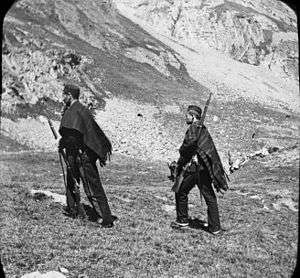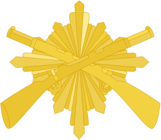Carabineros
| Carabineros Corps Cuerpo de Carabineros | |
|---|---|
| Common name | Carabineros |
|
Badge of the Carabineros Corps | |
| Motto |
Moralidad, lealtad, valor y disciplina Morality, loyalty, courage and discipline |
| Agency overview | |
| Formed | 1829 |
| Dissolved | 1940 |
| Superseding agency | Guardia Civil |
| Legal personality | Governmental: Government agency |
| Jurisdictional structure | |
| National agency | Spain |
| Governing body | Ministry of Finance |
| General nature | |
| Operational structure | |
| Overviewed by | Directorate-General of Security |

.jpg)
The Carabineros was an armed carabiniers force of Spain whose mission was to patrol the coasts and borders of the country operating against fraud and smuggling. It was established in 1829 and it lasted until 1940 when it was summarily disbanded and merged with the Guardia Civil.[1] [2]
The motto of the Carabineros was: Moralidad, lealtad, valor y disciplina. They were present along all the Spanish land borders, in the maritime provinces and in Madrid. Their uniform was dark blue until the 1920s and thereafter greyish green.
Among the notable commanders José Olaguer Feliú (1923-1927), José María Galán and Gonzalo Queipo de Llano (1934-1936) may be mentioned.
In 1936, during the Spanish Second Republic, there were 16,096 Carabineros. It was one of the units of law enforcement where the 1936 coup of the pro-Fascist generals found the least support. After Spain became divided in two, more than two thirds of the members of the corps remained loyal to the government of the Republic standing against the Francoist rebels.[3][4] Owing to their proven loyalty, during the Spanish Civil War the carabineros formed an elite unit and were integrated into the mixed brigades of the Republican Army.[5]
History
First 100 years of history
The Carabineros Corps was established as the 'Royal Carabinier Corps of the Coasts and Borders' (Real Cuerpo de Carabineros de Costas y Fronteras) by a royal decree issued by King Fernando VII on 9 March 1829. It was led by Field Marshal José Ramón Rodil at the time that Luis López Ballesteros was Minister of Finance.[6] Shortly thereafter, in 1833, the corps was renamed as 'Carabiniers of the Royal Finance' (Carabineros de la Real Hacienda). Being placed under the Finance Ministry they went through a period of gradual neglect and by 1842 the Carabineros were almost dysfunctional as a corps and Field Marshal Martín José de Iriarte was entrusted with their reorganization. Thus the corps was revamped and re-established as the 'Carabinier Corps of the Kingdom' (Cuerpo de Carabineros del Reino) in order to replace the former ineffective and discredited body.[6]
At the time of the Restoration the Carabineros and the Guardia Civil, the other paramilitary Spanish corps, were placed under the War Ministry, "for a better organization and discipline", being given a military character by means of a law[7] that developed and modified certain aspects of the 1878 Constitutive Army Law (Ley Constitutiva del Ejército). The latter set the functions of the Armed Forces following the Spanish Constitution of 1876.[8]
In August 1923 Lieutenant General José Olaguer Feliú was named General Director of the Carabineros.[9] Despite the times of economic hardship, he set to improve the sorry condition of the corps, reducing the daily working hours to twelve. He also achieved the expansion and improvement of the Carabinier Corps' Schools ( Colegios del Cuerpo de Carabineros) where the members were trained. He cared as well about building new quarters and repairing the existing ones, founding also schools for the sons and daughters of the Carabineros in certain locations. Finally José Olaguer Feliú also provided better schooling and conditions for orphans of Carabineros at the San Lorenzo de El Escorial Carabinier' Orphans School (Colegio de Huérfanos de Carabineros de San Lorenzo del Escorial).
In 1929, on the occasion of the 100th anniversary of the corps, a monument was built in recognition to the good labour of the Carabineros across the years at San Lorenzo del Escorial. Also the Great Cross of the Civil Order of Beneficence (Gran Cruz de la Orden Civil de Beneficencia) was granted collectively to the members of the corps by King Alfonso XIII for the many heroic deeds and services rendered by the Carabineros in fires, floods and the rescuing of shipwrecked persons.[10]
Royal Carabineros Seal; 1910. |
 Republican Carabineros Civil War standard. |
Spanish Civil War
At the beginning of the Civil War the rebellion of the Generals found little favour among the Carabineros which brought relief to the Republican government, eager to find loyal units to fight the first crucial battles of the war. In mid 1936 there had been a total about 16,096 men: 3 generals, 770 chiefs and officers, 1,169 sub-officers and 14,154 Carabineros. Approximately a third were on the territories that fell to the rebel side (between 5,000 and 6,000 men) after the coup and the two thirds that were on the areas controlled by the Republic (about 10,000) remained loyal to the established government. Thus the Carabinier Corps was rewarded with an increase in men and material in their ranks until reaching 40,000 men. The initiative was taken by then Finance Minister Juan Negrín.[11]
Mixed brigades
Certain units of the People's Republican Army were entirely made up of Carabineros, such as the 65th, 85th, 87th, 152nd, 179th, 211th, 222nd and 228th mixed brigades.[12] The 3rd[13] —the Tercera Brigada Mixta mentioned in the Si me quieres escribir song— and 5th[14] were among the most renowned mixed brigades of the loyalist army and saw action in most of the main battles of the civil war, including the Jarama, Brunete and the Teruel battles.[15]
End of the war and disbandment
The disbandment of the Carabineros corps following the Francoist victory was motivated by the resentment of the victorious faction against the carabinier units not having rebelled against the Republic after the coup. Since one of General Franco's —and also late General Sanjurjo's— main aims had been to annihilate the Spanish Republic and its supporters, a law was passed on 15 March 1940 by which the Spanish Dictatorship terminated the Cuerpo de Carabineros, integrating its assets into the Guardia Civil.[16] Article number 4 of the aforementioned law stated:
The present Inspección General de Carabineros is herewith removed. Its activities and functions will be taken over by a single section of the Dirección General de la Guardia Civil and all powers will be transferred to its General Director. The personnel of this corps will be assigned to the various services that will be defined by this law as exclusive to the Guardia Civil corps in the way that will be determined by its General Director according to the abilities and conditions of its personnel.[17]
Nine years after the end of Franco's Dictatorship the Spanish Law 37/1984 of 22 October recognized the rights and services of those who had been part of the Armed Forces, Police and Carabiniers of the Spanish Republic (Reconocimiento de derechos y servicios prestados a quienes durante la Guerra Civil formaron parte de las Fuerzas Armadas, Fuerzas de Orden Público y Cuerpo de Carabineros de la República). This law gave back to the surviving members of the corps some of the rights and recognition that had been taken away from them in 1940.[18]
See also
References
- ↑ Real decreto organizando el Cuerpo de Carabineros de Costas y Fronteras para impedir el contrabando, 31 de marzo de 1829 - Gaceta de Madrid nº39, p. 153
- ↑ Real decreto sobre la organización de Carabineros de Costas. Instituto, organización, personal e inspección general del Cuerpo de Carabineros de Costas y Fronteras. 2 de abril de 1829 - Gaceta de Madrid nº40, p. 157
- ↑ Alejandro de Quesada, The Spanish Civil War 1936–39 (2): Republican Forces, p. 36
- ↑ Henry Buckley & Paul Preston, The Life and Death of the Spanish Republic: A Witness to the Spanish Civil War, I.B.Tauris, 2013 ISBN 9781780769318
- ↑ Carlos Engel (1999); Historia de las Brigadas Mixtas del Ejército Popular de la República, p. 194, 221 and 225
- 1 2 Real decreto de organización del Cuerpo de Carabineros del Reino, 9 de diciembre 1842 - Gaceta de Madrid nº2985
- ↑ Ley Adicional a la Constitutiva del Ejército de 19 de julio de 1889]
- ↑ Ramón Gómez Martínez, El Estatuto Jurídico-Constitucional del militar de carrera en España. Antecedentes, fundamento y situación actual. Tesis doctoral. 2008 Universidad de Granada. Facultad de Derecho, P. 111-114
- ↑ Real decreto nombrando Director General de Carabineros al Teniente General D. José Olaguer-Feliu y Ramírez. "Gaceta de Madrid". Núm 209. 28 de julio de 1923, pp. 328
- ↑ Real decreto concediendo al Cuerpo de Carabineros la Gran Cruz de la Orden civil de Beneficencia, con distintivo negro y blanco, p. 1674, 10 de septiembre 1929 - Gaceta de Madrid nº253
- ↑ Hugh Thomas (1976); La Guerra civil española, Ed. Grijalbo, p. 594 (Spanish translation)
- ↑ Carlos Engel (1999); Historia de las Brigadas Mixtas del Ejército Popular de la República, pp. 194, 221 y 225
- ↑ SBHAC - 3.ª Brigada Mixta
- ↑ SBHAC - 5.ª Brigada Mixta
- ↑ Santiago Álvarez (1994); Negrín personalidad Histórica, Volume 1, p. 84
- ↑ Santiago Álvarez (1994); Negrín personalidad Histórica, Volume 1, pág. 79
- ↑ Se suprime la actual Inspección General de Carabineros, cuyos cometidos y funciones se agruparán en una sola Sección de la Dirección General de la Guardia Civil a cuyo Director General pasarán las atribuciones conferidas actualmente a la Inspección General del Cuerpo de Carabineros. El personal de este cuerpo estará adscrito a los distintos servicios que por esta Ley se fijen como privativos del Cuerpo de la Guardia Civil, en la forma que, con arreglo a las aptitudes y condiciones de su personal, determine el Director General. Ley del 15 de marzo de 1940. "B.O.E. (Boletín Oficial del Estado del Gobierno de España)". Núm. 77. 17 de marzo de 1940, pp. 1862 a 1866
- ↑ Ley 37/1984, de 22 de octubre, de reconocimiento de derechos y servicios prestados a quienes durante la guerra civil formaron parte de las Fuerzas Armadas, Fuerzas de Orden Público y Cuerpo de Carabineros de la República. "B.O.E. (Boletín Oficial del Estado del Gobierno de España)". Núm. 262. 1 de noviembre de 1984, pp. 31689 a 31690
External links
 Media related to Carabineros at Wikimedia Commons
Media related to Carabineros at Wikimedia Commons
